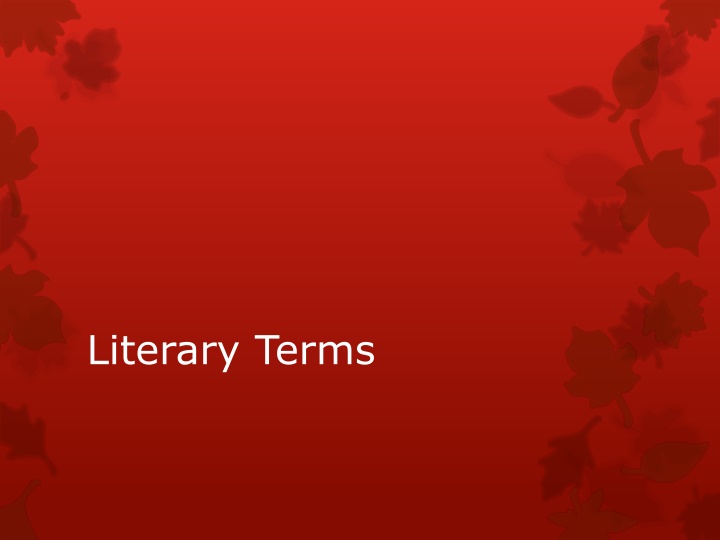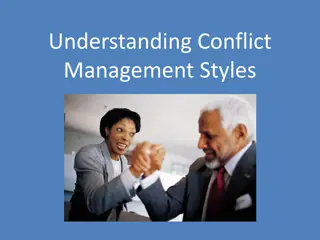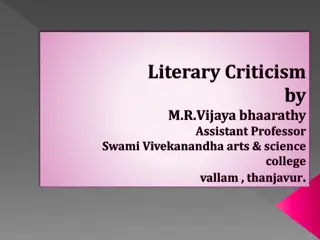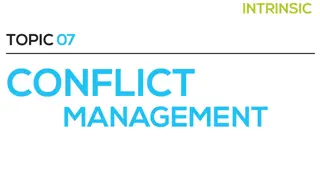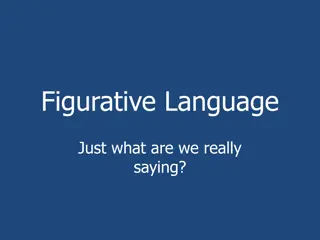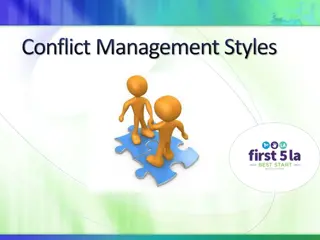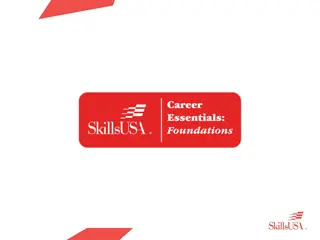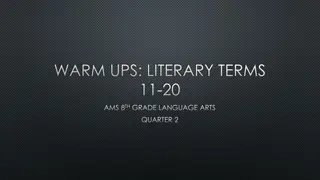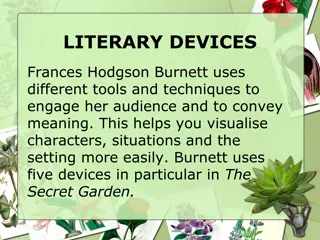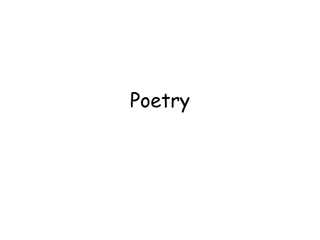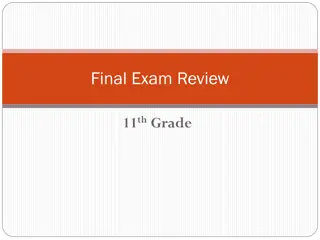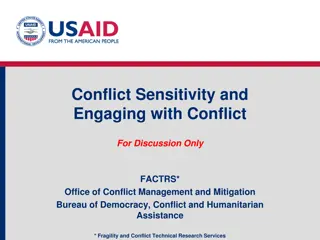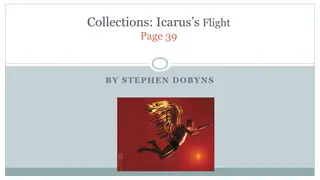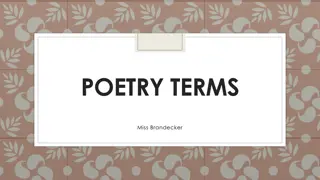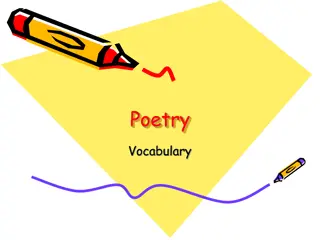Literary Terms Explained: From Alliteration to Conflict
Explore essential literary terms such as alliteration, allusion, analogy, antagonist, assonance, character, characterization, climax, and conflict. Learn about these terms and their examples to enhance your understanding of literature.
Download Presentation

Please find below an Image/Link to download the presentation.
The content on the website is provided AS IS for your information and personal use only. It may not be sold, licensed, or shared on other websites without obtaining consent from the author.If you encounter any issues during the download, it is possible that the publisher has removed the file from their server.
You are allowed to download the files provided on this website for personal or commercial use, subject to the condition that they are used lawfully. All files are the property of their respective owners.
The content on the website is provided AS IS for your information and personal use only. It may not be sold, licensed, or shared on other websites without obtaining consent from the author.
E N D
Presentation Transcript
Alliteration The repetition of beginning consonant sound in a line of poetry. Example: Sally sold seashells by the sea shore.
Allusion An allusion makes reference to a historical or literary person, place, or event with which the reader is assumed to be familiar. Many works of prose and poetry contain allusions to the Bible or classical mythology. "Oh, stop being such a Romeo," this would be an allusion to Romeo and Juliet.
Analogy Makes a comparison between two or more things that are similar in some ways but otherwise unlike. Example: Glove is to hand as paint is to wall Citizens are to president as solar system is to galaxy
Antagonist The antagonist (bad guy) is the character who is placed in opposition to the protagonist (good guy). He is a rival or enemy of the protagonist.
Assonance Similar vowel sound in stressed syllables that end with different consonant sounds. Example: Hear the lark and harken to the barking of the dark fox gone to ground
Character A person or an animal that takes part in the action of a literary work. A main or major character is the most important character in a story, poem, or play. A minor character plays a lesser role but is necessary for the story to develop.
Characterization The process by which author s create memorable characters. Authors use two major methods of characterization direct and indirect. Direct an author tells what the character is like looks and actions. Indirect a writer reveals a character s personality through his or her own appearance, words, actions, and effects on others. Sometimes the writer describes what other participants in the story say and think about the character. The reader draws his/her own conclusions about the character being analyzed.
Climax The turning point in a story. The point of highest interest. It is the OMG!!!! Moment
Conflict The struggle which grows out of the interplay of the two opposing forces in a plot. At least one of the opposing forces is usually a person.
Connotation The implications, inferences, or suggestive power of words, phrases, or figures of speech. rock-- a small dirty one from the garden rock-- a big diamond cat-- a sweet housecat cat-- an angry mountain lion dog-- a house pet dog-- a guy leering at a girl box-- a cardboard package box-- two men duking it out with gloves
Denotation The exact or dictionary meaning of a word without its emotional or suggestive associations.
Dialect A form of language spoken by people in a particular region or group. Dialects differ in pronunciations, grammar, and word choice. Writers use dialect to make their characters seem realistic.
Diction The choice and arrangement of words in phrases and images or in larger units such as poetic lines and sentences.
Flashback A scene in a short story, novel, play, or narrative poem that interrupts the action to show an event that happened earlier.
Foreshadowing The author s use of clues to hint at what might happen next in the story. It is used to build the reader s sense of expectations or to create suspense. http://www.youtube.com/watch?v=adesE9eVIV4&feature=p layer_detailpage
Hyperbole A figure of speech in which conscious exaggeration is used without the intent of literal persuasion. It may be used to heighten effect, or it may be used to produce comic effect. My house is a million miles from here!! My mom is going to kill me!! http://www.youtube.com/watch?v=BMMB8c TrxUs
Idiom An expression whose meaning is different from the sum of the meanings of its individual words. http://www.youtube.com/watch?v= qXcZD_mW8SE&feature=related
Imagery Words and phrases create vivid sensory experiences for the reader. Though sight imagery is most common, imagery may appeal to any of the senses.
Irony The general name given to literary techniques that involve surprising, interesting, or amusing contradictions. http://www.youtube.com/watch?v=J ne9t8sHpUc&feature=player_detailp age
Metaphor A comparison between two unlike things http://www.youtube.com/watch?v= eFgRj-5d5Ac EX: Life is a journey, travel it well. Her home was a prison. John is a real pig when he eats.
Mood The feeling or atmosphere that a writer creates for the reader. Connotative words, sensory images, and figurative language contribute to the mood of a selection, as do the sound and rhythm of the language. http://www.youtube.com/watch?v=f1LEeaAyqHs
Narrator A speaker or character who tells a story Third person narrator one who stands outside the action and speaks about it. First person narrator one who tells a story and participates in the action.
Onomatopoeia The use of words which by their pronunciation suggest their meaning. The words literally represent the sound. http://www.youtube.com/watch?v=q-BVwwKTjlI
Oxymoron Contradiction; two contradictory terms or ideas are used together. Seriously funny Pretty ugly Only choice Alone together Living dead
Personification Gives inanimate objects characteristics of life Example: And memory sleeps beneath the gray and windless sky . Rain in my heart http://www.youtube.com/watch?v=RKexdSZNiLc
Plot the sequence of events in which each event results from a previous one and causes the next. In most novels, dramas, short stories, and narrative poems, the plot usually involves both characters in a central conflict. The plot usually begins with an exposition that introduces the setting, the characters, and the basic situation. This is followed by rising action, in which the central conflict is introduced and developed. The conflict then increases until it reaches a high point of interest or suspense, the climax. The climax is followed by the falling action, or the end of the central conflict. Any events that occur during the falling action make up the resolution.
Point of View Point of view refers to the narrative method used in a short story, novel, or nonfiction selection. 1 first person The narrator is a character in the story, narrating the action as he or she understands it. First person point of view is indicated by the pronoun I. 2 third person A third person narrator is not a participant in the action and thus maintains a certain distance from the characters. Third person point of view is indicated by he use of the pronouns he, she, it, and they. 3 third person omniscient The narrator is all-knowing about the thoughts and feelings of the characters. With this point of view, the writer can reveal the emotional responses of all the characters and can comment at will on the events taking place. 4 third person limited The writer presents events as experienced by only one character.
Protagonist The protagonist is the character in opposition to the antagonist, the chief character in a drama or work of fiction.
Pun a play on the meaning of words. Example: When a clock is hungry, it goes back four seconds. A boiled egg every morning is hard to beat. I went to buy some camouflage trousers yesterday but couldn't find any. She had a photographic memory but never developed it.
Repetition the use, more than once, of any element of language a sound, word, phrase, clause, or sentence. Because I do not hope to turn again Because I do not hope Because I do not hope to turn... from 'Ash-Wednesday' by T. S. Eliot
Rhyme The use of matching sounds, generally accented vowels, at the end of two lines or more of poetry. It contributes to the musical quality of poetry.
Sarcasm A form of verbal irony in which, under the guise of praise, a caustic and bitter expression of strong and personal disapproval is given. Sarcasm is personal, jeering, intended to hurt, and is intended as a sneering taunt. http://www.youtube.com/watch?v=UBztjzDr 0fM&feature=player_detailpage
Setting the time and place of the action. The setting includes all the details of a place and time the year, the time of day, even the weather. The place may be a specific country, state, region, community, neighborhood, building, institution, or home. Details such as dialect, clothing, customs, and modes of transportation are often used to establish the setting.
Shift a change in tone, mood, setting, or characterization that affects the movement of the selection.
Simile a comparison between two unlike things using the words like or as The rugby ball was like a giant egg, which he held carefully while he ran. http://www.youtube.com/watch?v=Ou8Mi_7eEA0
Suspense a feeling of anxious uncertainty about the outcome of events in a literary work. http://youtu.be/sKiAzMx8N7Y
Symbol Any object, happening, person, or place which stands not only for itself but also for something else. EX: Bow Tie is a symbol of dignity, honesty, and respectability. Roses stand for romance or love white symbolizes purity flag symbolizes freedom http://www.youtube.com/watch?v=bXJUq4kdGAE
Theme The main idea or message a writer expresses in a work of literature. It is a writer s perception about life or humanity shared with a a reader. Themes are seldom stated directly. http://www.youtube.com/watch?v=CZUiq17QDxQ
Tone The attitude a writer takes toward a subject. It might be humorous, serious, bitter, angry, or detached among other possibilities. http://www.schooltube.com/video/48eb1dfd0578827463 c3/Tone-Mood-in-Forrest-Gump
